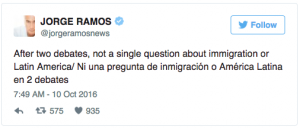There were various things that I found interesting when looking into Gary Johnson & his immigration rhetoric. The first being the way that Johnson attempted to frame himself in order to appear more relatable to immigrants and minorities. He elaborated on living a huge portion of his life in New Mexico, a boarder state, which he claimed made him more qualified to understand immigrants & the mutual dependence that America has on immigrants and visa versa. Johnson also did a great job on playing on the emotions of immigrants and people who perceive immigration to be either harmless or helpful to The U.S. by reiterating that immigrants, “take the jobs that Americans don’t want” and also, “create jobs by being here” on numerous occasions. However, out of all of his immigration rhetoric, Johnson’s take on immigration reform was one of the most interesting things I came across. His attempt to dissociate himself from the rest of politicians when speaking about immigration was especially unique when he stated, “If we are going to deport people because they are costing America jobs how about we start with the politicians causing the problem?!” in a major campaign video on his website. These tactics are ‘okay’, these tactics are solid, these tactics appeal primarily to minority votes- but they can get Johnson SOMEWHERE, right?!?!
Well… Right, kinda. These particular tactics were not ineffective; in fact, Johnson pulled the same number of votes from Latinos (16%) that Donald Trump did. Which leads me to the question: WHY didn’t the votes from Latinos for Johnson put Trump’s 6 feet under? Well, unfortunately for Johnson, he has really “gaffed” up numerous times throughout his campaign and is appearing to be less and less qualified AND educated, two major presidential characteristics.
After considering his “Aleppo” gaffe, his inability to name a foreign leader when asked to, or the time that he willingly admitted that his lack of knowledge on foreign leaders made him a better candidate than Clinton, I began to wonder… Which gaffe, which off-the-wall statement, at what moment did Gary Johnson lose a huge chunk of the minority vote? Then, I had an ah-ha! moment. Johnson, a man who viciously objects to using the term ‘illegal immigrant,’ was asked in an interview why he was so strongly opposed to the term. His response, “It just is. Just so that you know. Just so that you know and you don’t have to use that term. They came into this country because they couldn’t get in legally and the jobs existed and you or I would have done the same thing,” was effortless & was accounted for as a “Gary Johnson moment”. While many Johnson supporters are proud that he even had a response after lack there of on a few occasions, his response was in no way beneficial to immigrants, it did not give a convincing argument as to why the term “illegal immigrant” was offensive or should be avoided and it did NOT exemplify a sophisticated and well-informed presidential response. While Johnson has executed some decent immigration rhetoric and has opted for a palatable alternative for immigration reform in contrast to the other presidential candidates, his gaffes and blank moments have convinced voters that he is literally h i g h. While everyone enjoys a good stoner, not many are willing to have vote one as our president. For these reasons, Johnson is far, FAR behind both DT and HRC, leaving him with no chance in winning this election. As the election day approaches, Johnson’s poll numbers have depleted and I believe that his polls will continue to do so as more people are exposed to his “Johnsonisms” through the media. 












